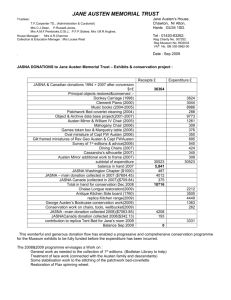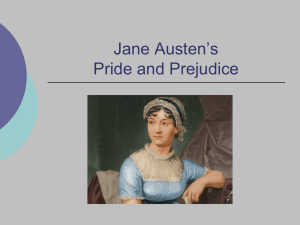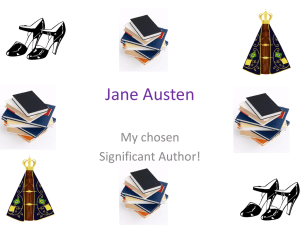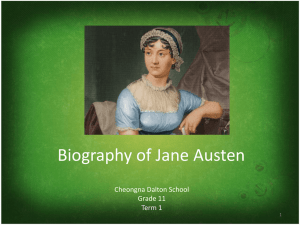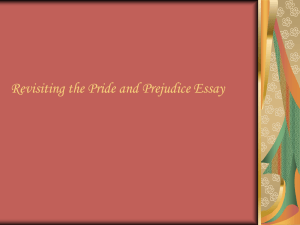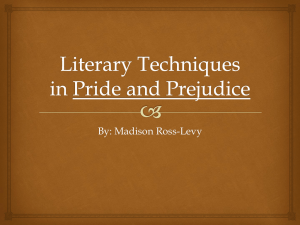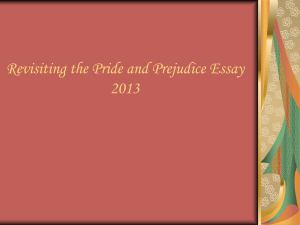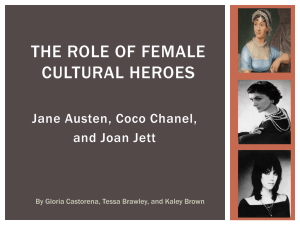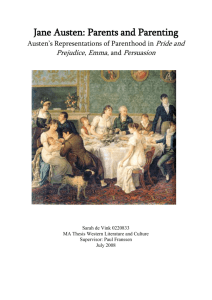Austen and Paradox
advertisement
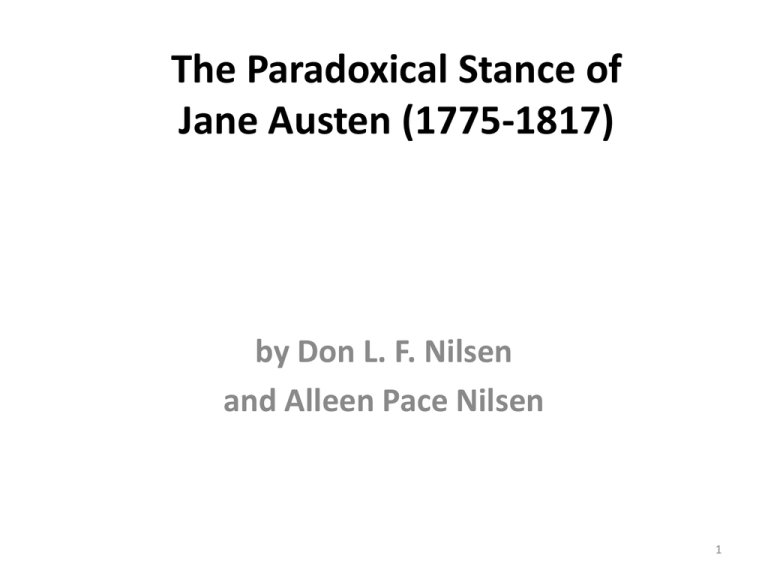
The Paradoxical Stance of Jane Austen (1775-1817) by Don L. F. Nilsen and Alleen Pace Nilsen 1 Jane Austen as drawn by her sister, Cassandra 2 Austen’s Satirical Targets • Jane Austen’s novels tend to be about two things: • Marriage • And • Money 3 Austen: A Female Writer in a Male Dominated Society • Robert Polhemus feels that Austen’s sense of the ridiculous, her sense of irony, and her sense of humor were her reactions to a male dominated, parochial moral order. • Polhemus said that Austen had a kind of “feminine lawlessness.” 4 Austen as a Feminist • The problem with Jane Austen is that both liberal and conservative critics claim that she supports their point of view. • In truth, Austen’s style is paradoxical. • Kate Fullbrook observes that “She speaks precisely in the voice of the culture she mocks.” 5 Irony and Disguise • Regina Barreca says that Austen’s novels are written in disguise: • “To read her works without taking the disguise into account is to misread refusal as inability, irony as sentiment, consider contempt as pleasant affection, and women’s comedy for men’s.” 6 Austen’s Little Men • Barreca continues, “Austen’s men are of little consequence apart from how they function in the lives of the female characters.” • “The only important things about men are their marital status, income, rank, and looks.” • “Men, in Jane Austen, are at their best when they are out of the room.” 7 Sense and Sensibility (1811) • Sense and Sensibility exposes the silliness of the sentimental and Gothic novels that were so popular during Austen’s day. • It is a Comedy of Manners that uses the device of reductio ad absurdum very effectively. 8 Sensibility vs. Sense • Marianne Dashwood is guided by feeling or sensibility. • Marianne’s sister, Elinor Dashwood, is guided by reason and sense. • Marianne’s ardor and passion are contrasted with Elinor’s coolness of judgment. 9 Elinor, the Detective • In the tradition of Sherlock Holmes, Hercule Poirot, Miss Marpole, and Columbo, Elinor is a detective who examines all of the empirical evidence. • Elinor uses evesdropping and spying to discover the true character of Edward Ferrars. • Elinor is interested in Edward Ferrars, and she believes that this will help her in gaining his affections. 10 Pride and Prejudice (1813) • This novel begins with one of the best opening lines in all of literature, as Mrs. Bennett says: • “It is a truth universally acknowledged, that a single man in possession of a good fortune, must be in want of a wife.” • Later in the novel, Austen further characterizes Mrs. Bennett: “She was a woman of mean understanding, little information and uncertain temper.” 11 Mrs. Bennett • “When she was discontinent she fancied herself nervous.” • “The business of her life was to get her daughters married; its solace was visiting and news.” 12 In Comedies there is an Unjust Law • Northrup Frye says that one of the features of “Comedy” is that there tends to be an “unjust law” that is somehow thwarted in the comedy. • In Pride and Prejudice the unjust law is that inheritance must go from male to male, and since the Bennets have only daughters, their estate is to go to William Collins, a distant male relative. 13 William Collins and His Assumption • Since William Collins is to inherit the Bennet estate, he assumes that he will also inherit his choice of the Bennet girls as his wife. • Both William Collins and Mrs. Bennet are targets of Austen’s satire. • Austen contrasts the long-winded pomposity of Mr. Collins with the hysterical protests of Mrs. Bennet. 14 Mr. Bennet • In contrast, Mr. Bennet’s laconic cynicism can be seen in the following dialogue: • “Come here, child,” cried her father as she appeared. “I have sent for you on an affair of importance. I understand that Mr. Collins has made you an offer of marriage. Is it true?” • Elizabeth replied that it was. “Very well—and this offer of marriage you have refused?” • I have, sir.” 15 • “Very well. We now come to the point. Your mother insists upon your accepting it,. Is it not so, Mrs. Bennet?” • “Yes, or I will never see her again.” • “An unhappy alternative is before you, Elizabeth. From this day you must be a stranger to one of your parents. • Your mother will never see you again if you do not marry Mr. Collins. • And I will never see you again if you do.” 16 Elizabeth and Mr. Darcy • Elizabeth is sharp witted and a bit uncontrolled or wild. She disagrees with Mr. Darcy when he says that there are certain things not to be laughed at. • Mr. Darcy is so proud a man that even at the moment of declaring his love to Elizabeth, he doesn’t allow humility or modesty into his speech. He is proud and arrogant in not understanding why Elizabeth has rejected his proposal. • Thus, Darcy is accusing Elizabeth of being uncivil, while he himself is acting like a pompous ass. • But Darrel Mansell thinks that even in Elizabeth, there is something bordering on conceit and impertinance. 17 Emma (1816) • If marriage is so important to Jane Austen, then why did Austen never marry? • Robert Polhemus suggests that Austen did marry, as she tells us, “Emma, the striving, kinetic, lucky, ironic, ridiculous subjective comic heroine weds Knightly.” • Just as Queen Elizabeth, the Virgin Queen, became wedded to England, Jane Austen became wedded to her characters. 18 Emma as Comedy of Humors • The “humours” characters see everything in the extreme of their ruling passion: • Mr. Weston, the sanguine, can scarcely think ill of anyone. • The hypochondriac Mr. Woodhouse, likes his germs and gruel. • Mrs. John Knightly can not understand anything not related to the welfare of her children. • Mrs. Elton can’t look beyond the Maple Grove and the barouchelandau. 19 Harriet Smith • Harriet Smith was a very pretty girl, and her beauty happened to be of a sort which Emma particularly admired. • She was short, plump and fair, with a fine bloom, blue eyes, light hair, regular features, and a look of great sweetness. • Since Emma herself is tall and elegant, and has hazel eyes, Harriet provides a perfect foil for Emma’s charms. 20 The Three Threads of Emma • Bruce Stovel believes that there are three threads being developed in Emma: • First is the hidden love that Emma and Mr. Knightley have for each other. • Second is the counterpoint of the secret love and secret engagement of Frank Churchill and Jane Fairfax. • And third is the use of other characters in the novel to compare and contrast with the various aspects of Emma herself. 21 Northanger Abbey (1818) • Northanger Abby targets the sentimentalism that was so much part of a girl’s education during Austen’s time. • It also targets the Gothic Novel in general, and Ann Radcliffe’s The Romance of the Forest (1791) in particular. • In Northanger Abbey, Catherine Morland discovers a laundry bill that confirms her dire suspicions that General Tilney is somehow involved with his wife’s death. 22 • Austen’s parodic and mocking tone can be seen in the following passage: • “Catherine had reached the age of seventeen without having seen one amiable youth who could call forth her sensibility. • There was not one lord in the neighbourhood; no—not even a baronet…not one young man whose origin was unknown. • Her father had no ward, and the squire of the parish no children. • Catherine reasons, “When a young lady is to be a heroine, the perverseness of forty surrounding families cannot prevent her. Something must and will happen to throw a hero in her way.” 23 • At midnight, Catherine explores Northanger Abbey, and finds a manuscript which she takes to be a cryptic record of secret crimes committed and suffered in the Abbey, • But on closer examination, this manuscript turns out to be an inventory of linen needing to be washed. • Northanger Abbey is in fact a Gothic Novel. • But at the same time it is also a parody of a Gothic novel. The Gothic novel genre is always over the top and exaggerated. But Northanger Abbey is even more over the top than are other Gothic novels. • And therein lies the irony and the paradox of Jane Austen’s style. 24 Jane Austen’s Birthday: Hamilton Library in Chandler, AZ 25 Jane Austen and Paradox” Jane Austen and Paradox: http://en.wikipedia.org/wiki/Jane_Austen 26
